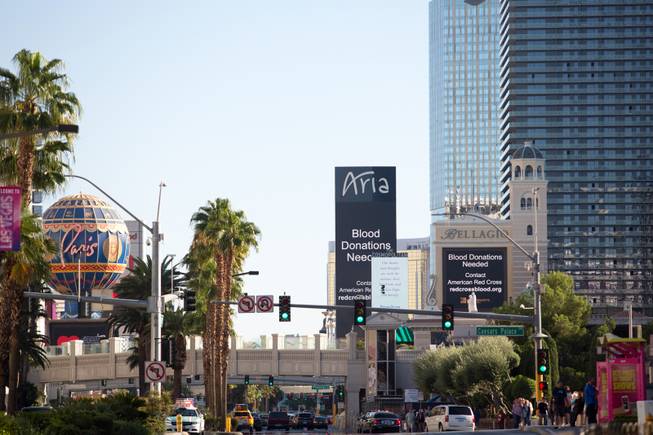
Casinos all along the Las Vegas Strip display words of prayer for the victims of Sunday night’s deadly mass shooting, as well as, information for donating blood and locating missing loved ones, Monday Oct. 2, 2017.
Tuesday, Oct. 3, 2017 | 2 a.m.
Related content
- List of fatalities: Off-duty Metro officer is among the deceased in Vegas mass shooting
- Brother: Las Vegas gunman was wealthy real-estate investor
- At least 59 dead, 527 injured in mass shooting on Las Vegas Strip
- Las Vegas shooting leaves GOP-backed gun bills in limbo
- ‘It was just mass, mass blood everywhere’: Survivors recount Las Vegas attack
- Local sports community reacts to mass shooting
- More coverage of the mass shooting
Las Vegas' $60 billion tourism economy might see little impact in the wake of Sunday's massacre at an outdoor country music festival, if Orlando's experience following last year's Pulse nightclub mass shooting is any indication.
Orlando's tourism numbers wound up growing by 2 million to 68 million visitors in 2016, despite 29-year-old security guard Omar Mateen's killing of 49 people and wounding of 58 at Pulse, a gay nightclub, that June.
"Our hearts are with Las Vegas right now," Visit Orlando CEO George Aguel said in a statement. "Following the Pulse tragedy, what we saw was an incredible outpouring of support from people all over the world — for Orlando as a community, as well as a cherished travel destination."
Rossi Ralenkotter, CEO of the Las Vegas Convention and Visitors Authority, wasn't giving interviews Monday, but in a statement called the shootings a "horrific, yet isolated, incident." The massacre killed at least 59 people and injured 527 others at a festival across from the Mandalay Bay on the Las Vegas Strip.
"At this time, it is important to allow the Las Vegas Metropolitan Police to conclude their investigation into the incident and to attend to the needs of the victims and their families," Ralenkotter said in the statement. "Las Vegas is a strong community that will work through this tragic incident."
Las Vegas saw record visitor numbers for the third consecutive year in 2016, when it welcomed 42.9 million visitors, according to the authority. It hosted 57 of the 250 largest trade shows, and Trade Show News Network named it the country's top trade show destination for the 23rd year in a row. Tourism supports about 407,000 total jobs, or 44 percent of the workforce, and contributes about $16.9 billion in local wages.
